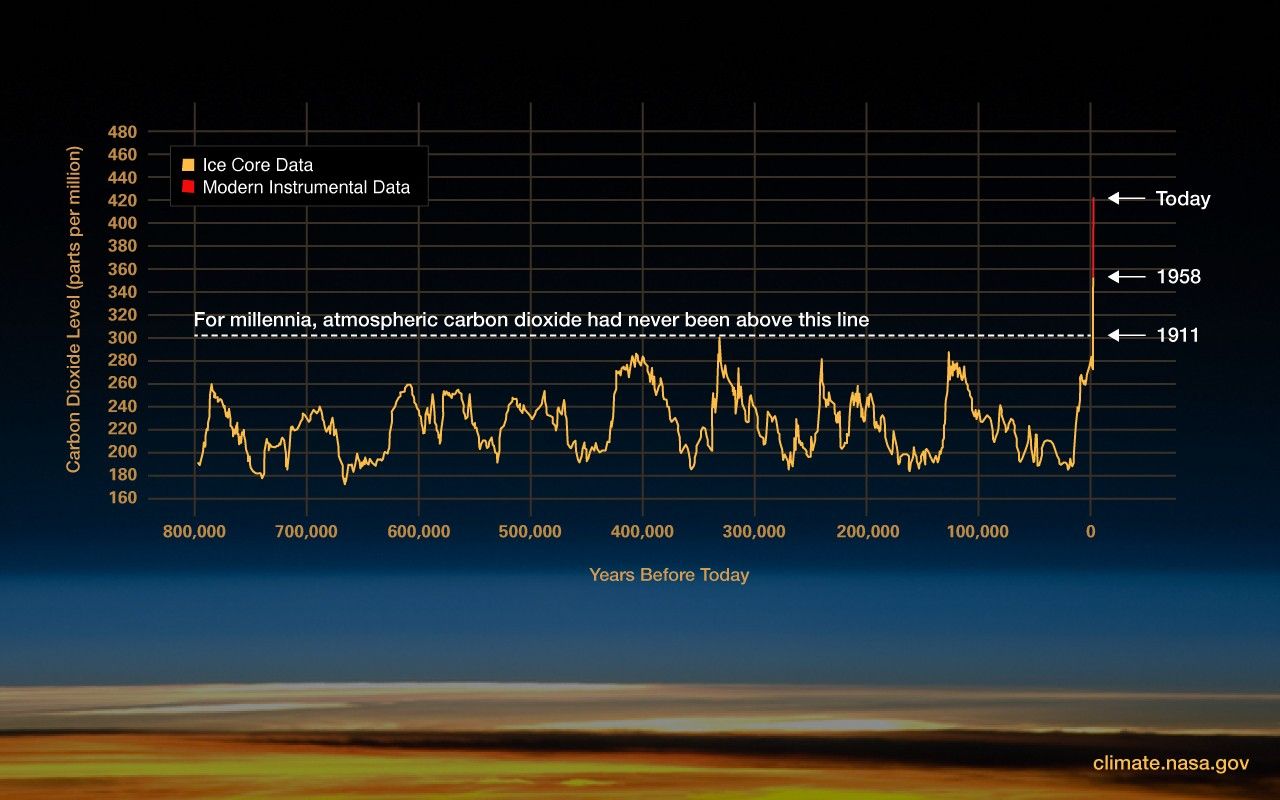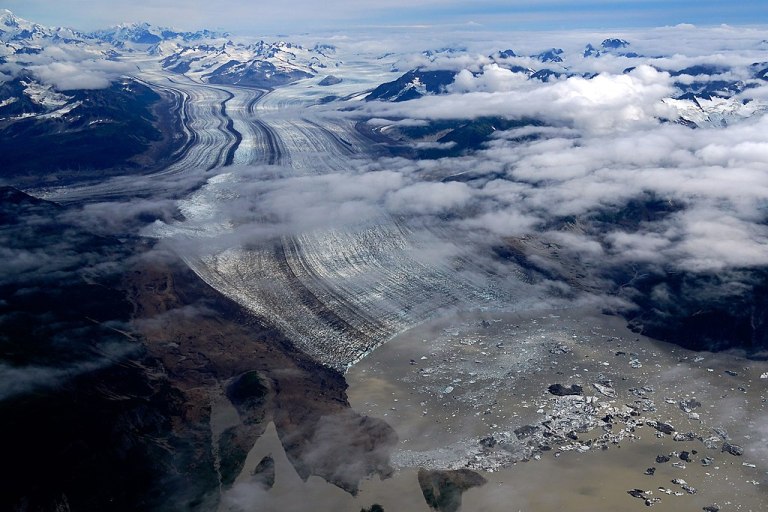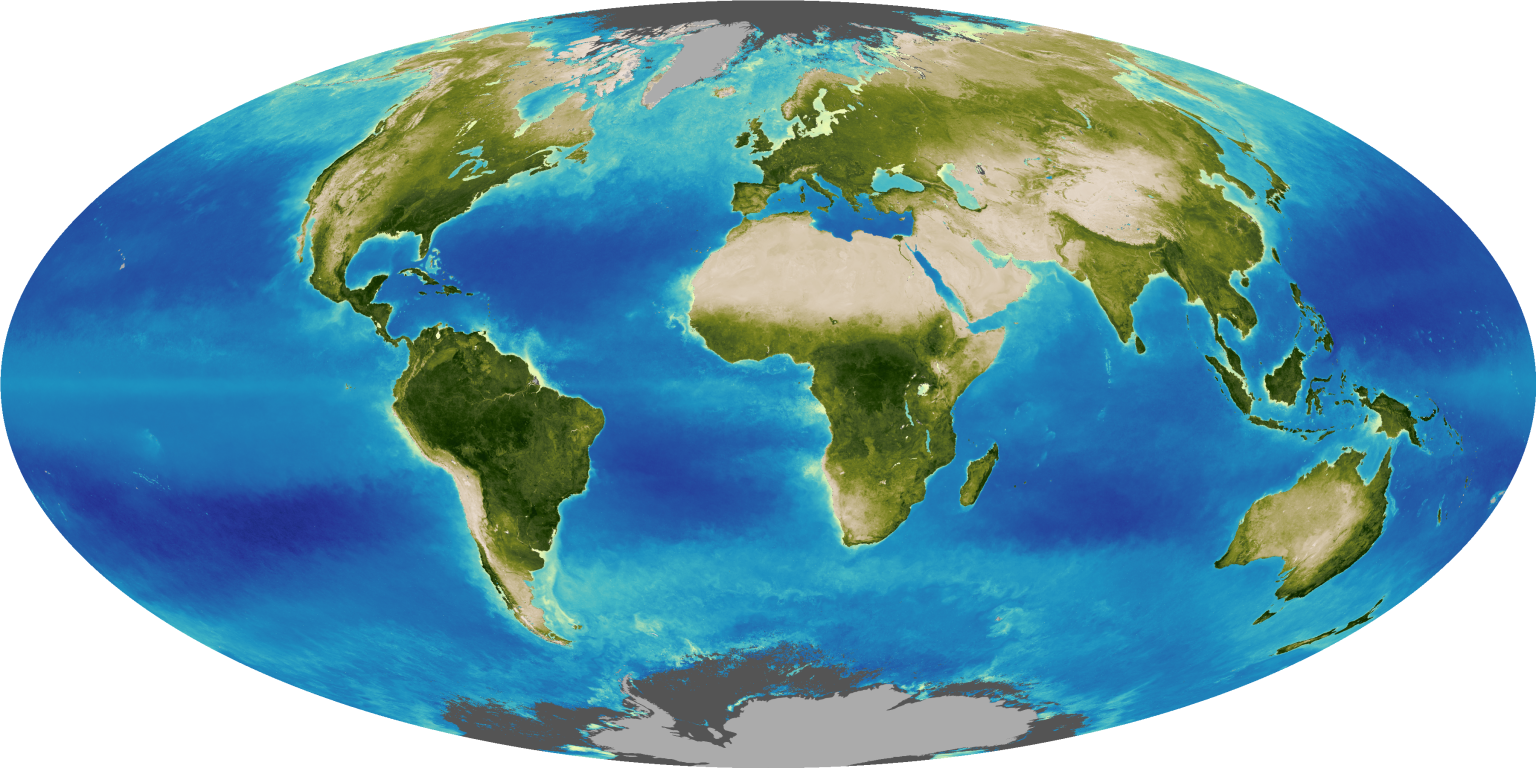Takeaways
- While Earth’s climate has changed throughout its history, the current warming is happening at a rate not seen in the past 10,000 years.
- According to the Intergovernmental Panel on Climate Change (IPCC), "Since systematic scientific assessments began in the 1970s, the influence of human activity on the warming of the climate system has evolved from theory to established fact."1
- Scientific information taken from natural sources (such as ice cores, rocks, and tree rings) and from modern equipment (like satellites and instruments) all show the signs of a changing climate.
- From global temperature rise to melting ice sheets, the evidence of a warming planet abounds.
The rate of change since the mid-20th century is unprecedented over millennia.
Earth's climate has changed throughout history. Just in the last 800,000 years, there have been eight cycles of ice ages and warmer periods, with the end of the last ice age about 11,700 years ago marking the beginning of the modern climate era — and of human civilization. Most of these climate changes are attributed to very small variations in Earth’s orbit that change the amount of solar energy our planet receives.

The current warming trend is different because it is clearly the result of human activities since the mid-1800s, and is proceeding at a rate not seen over many recent millennia.1 It is undeniable that human activities have produced the atmospheric gases that have trapped more of the Sun’s energy in the Earth system. This extra energy has warmed the atmosphere, ocean, and land, and widespread and rapid changes in the atmosphere, ocean, cryosphere, and biosphere have occurred.
Earth-orbiting satellites and new technologies have helped scientists see the big picture, collecting many different types of information about our planet and its climate all over the world. These data, collected over many years, reveal the signs and patterns of a changing climate.
Scientists demonstrated the heat-trapping nature of carbon dioxide and other gases in the mid-19th century.2 Many of the science instruments NASA uses to study our climate focus on how these gases affect the movement of infrared radiation through the atmosphere. From the measured impacts of increases in these gases, there is no question that increased greenhouse gas levels warm Earth in response.
Scientific evidence for warming of the climate system is unequivocal.

Intergovernmental Panel on Climate Change
Ice cores drawn from Greenland, Antarctica, and tropical mountain glaciers show that Earth’s climate responds to changes in greenhouse gas levels. Ancient evidence can also be found in tree rings, ocean sediments, coral reefs, and layers of sedimentary rocks. This ancient, or paleoclimate, evidence reveals that current warming is occurring roughly 10 times faster than the average rate of warming after an ice age. Carbon dioxide from human activities is increasing about 250 times faster than it did from natural sources after the last Ice Age.3
The Evidence for Rapid Climate Change Is Compelling:
-
Global Temperature Is Rising
The planet's average surface temperature has risen about 2 degrees Fahrenheit (1 degrees Celsius) since the late 19th century, a change driven largely by increased carbon dioxide emissions into the atmosphere and other human activities.4 Most of the warming occurred in the past 40 years, with the seven most recent years being the warmest. The years 2016 and 2020 are tied for the warmest year on record.5
Image credit: Ashwin Kumar, Creative Commons Attribution-Share Alike 2.0 Generic.
-
The Ocean Is Getting Warmer
The ocean has absorbed much of this increased heat, with the top 100 meters (about 328 feet) of ocean showing warming of 0.67 degrees Fahrenheit (0.33 degrees Celsius) since 1969.6 Earth stores 90% of the extra energy in the ocean.
Image credit: Kelsey Roberts/USGS
-
The Ice Sheets Are Shrinking
The Greenland and Antarctic ice sheets have decreased in mass. Data from NASA's Gravity Recovery and Climate Experiment show Greenland lost an average of 279 billion tons of ice per year between 1993 and 2019, while Antarctica lost about 148 billion tons of ice per year.7
Image: The Antarctic Peninsula, Credit: NASA
-
Glaciers Are Retreating
Glaciers are retreating almost everywhere around the world — including in the Alps, Himalayas, Andes, Rockies, Alaska, and Africa.8
Image: Miles Glacier, Alaska Image credit: NASA
-
Snow Cover Is Decreasing
Satellite observations reveal that the amount of spring snow cover in the Northern Hemisphere has decreased over the past five decades and the snow is melting earlier.9
Image credit: NASA/JPL-Caltech
-
Sea Level Is Rising
Global sea level rose about 8 inches (20 centimeters) in the last century. The rate in the last two decades, however, is nearly double that of the last century and accelerating slightly every year.10
Image credit: U.S. Army Corps of Engineers Norfolk District TANGIER, Va. -- A resident of Tangier, Virginia, walks along a road covered by tidal flood waters here September 16, 2016. The small Chesapeake Bay island community of roughly 470 residents are experiencing the impacts of sea level rise, erosion and land subsidence. Scientist estimate the island may become uninhabitable over the next 25 to 50 years if something is not done to help keep the island above water. (U.S. Army photo/Patrick Bloodgood)
TANGIER, Va. -- A resident of Tangier, Virginia, walks along a road covered by tidal flood waters here September 16, 2016. The small Chesapeake Bay island community of roughly 470 residents are experiencing the impacts of sea level rise, erosion and land subsidence. Scientist estimate the island may become uninhabitable over the next 25 to 50 years if something is not done to help keep the island above water. (U.S. Army photo/Patrick Bloodgood) -
Arctic Sea Ice Is Declining
Both the extent and thickness of Arctic sea ice has declined rapidly over the last several decades.11
Credit: NASA's Scientific Visualization Studio
-
Extreme Events Are Increasing in Frequency
The number of record high temperature events in the United States has been increasing, while the number of record low temperature events has been decreasing, since 1950. The U.S. has also witnessed increasing numbers of intense rainfall events.12
Image credit: Régine Fabri, CC BY-SA 4.0, via Wikimedia Commons
-
Ocean Acidification Is Increasing
Since the beginning of the Industrial Revolution, the acidity of surface ocean waters has increased by about 30%.13, 14 This increase is due to humans emitting more carbon dioxide into the atmosphere and hence more being absorbed into the ocean. The ocean has absorbed between 20% and 30% of total anthropogenic carbon dioxide emissions in recent decades (7.2 to 10.8 billion metric tons per year).15, 16
Image credit: NOAA
References
1. IPCC Sixth Assessment Report, WGI, Technical Summary.
B.D. Santer et.al., “A search for human influences on the thermal structure of the atmosphere.” Nature 382 (04 July 1996): 39-46. https://doi.org/10.1038/382039a0.
Gabriele C. Hegerl et al., “Detecting Greenhouse-Gas-Induced Climate Change with an Optimal Fingerprint Method.” Journal of Climate 9 (October 1996): 2281-2306. https://doi.org/10.1175/1520-0442(1996)009<2281:DGGICC>2.0.CO;2.
V. Ramaswamy, et al., “Anthropogenic and Natural Influences in the Evolution of Lower Stratospheric Cooling.” Science 311 (24 February 2006): 1138-1141. https://doi.org/10.1126/science.1122587.
B.D. Santer et al., “Contributions of Anthropogenic and Natural Forcing to Recent Tropopause Height Changes.” Science 301 (25 July 2003): 479-483. https://doi.org/10.1126/science.1084123.
T. Westerhold et al., "An astronomically dated record of Earth’s climate and its predictability over the last 66 million years." Science 369 (11 Sept. 2020): 1383-1387. https://doi.org/10.1126/science.1094123
2. In 1824, Joseph Fourier calculated that an Earth-sized planet, at our distance from the Sun, ought to be much colder. He suggested something in the atmosphere must be acting like an insulating blanket. In 1856, Eunice Foote discovered that blanket, showing that carbon dioxide and water vapor in Earth's atmosphere trap escaping infrared (heat) radiation.
In the 1860s, physicist John Tyndall recognized Earth's natural greenhouse effect and suggested that slight changes in the atmospheric composition could bring about climatic variations. In 1896, a seminal paper by Swedish scientist Svante Arrhenius first predicted that changes in atmospheric carbon dioxide levels could substantially alter the surface temperature through the greenhouse effect.
In 1938, Guy Callendar connected carbon dioxide increases in Earth’s atmosphere to global warming. In 1941, Milutin Milankovic linked ice ages to Earth’s orbital characteristics. Gilbert Plass formulated the Carbon Dioxide Theory of Climate Change in 1956.
3. IPCC Sixth Assessment Report, WG1, Chapter 2
Vostok ice core data; NOAA Mauna Loa CO2 record
O. Gaffney, W. Steffen, "The Anthropocene Equation." The Anthropocene Review 4, issue 1 (April 2017): 53-61. https://doi.org/abs/10.1177/2053019616688022.
4. https://www.ncei.noaa.gov/monitoring
https://crudata.uea.ac.uk/cru/data/temperature/
http://data.giss.nasa.gov/gistemp
5. https://www.giss.nasa.gov/research/news/20170118/
6. S. Levitus, J. Antonov, T. Boyer, O Baranova, H. Garcia, R. Locarnini, A. Mishonov, J. Reagan, D. Seidov, E. Yarosh, M. Zweng, "NCEI ocean heat content, temperature anomalies, salinity anomalies, thermosteric sea level anomalies, halosteric sea level anomalies, and total steric sea level anomalies from 1955 to present calculated from in situ oceanographic subsurface profile data (NCEI Accession 0164586), Version 4.4. (2017) NOAA National Centers for Environmental Information.
https://www.nodc.noaa.gov/OC5/3M_HEAT_CONTENT/index3.html
K. von Schuckmann, L. Cheng, L,. D. Palmer, J. Hansen, C. Tassone, V. Aich, S. Adusumilli, H. Beltrami, H., T. Boyer, F. Cuesta-Valero, D. Desbruyeres, C. Domingues, A. Garcia-Garcia, P. Gentine, J. Gilson, M. Gorfer, L. Haimberger, M. Ishii, M., G. Johnson, R. Killick, B. King, G. Kirchengast, N. Kolodziejczyk, J. Lyman, B. Marzeion, M. Mayer, M. Monier, D. Monselesan, S. Purkey, D. Roemmich, A. Schweiger, S. Seneviratne, A. Shepherd, D. Slater, A. Steiner, F. Straneo, M.L. Timmermans, S. Wijffels. "Heat stored in the Earth system: where does the energy go?" Earth System Science Data 12, Issue 3 (07 September 2020): 2013-2041. https://doi.org/10.5194/essd-12-2013-2020.
7. I. Velicogna, Yara Mohajerani, A. Geruo, F. Landerer, J. Mouginot, B. Noel, E. Rignot, T. Sutterly, M. van den Broeke, M. Wessem, D. Wiese, "Continuity of Ice Sheet Mass Loss in Greenland and Antarctica From the GRACE and GRACE Follow-On Missions." Geophysical Research Letters 47, Issue 8 (28 April 2020): e2020GL087291. https://doi.org/10.1029/2020GL087291.
8. National Snow and Ice Data Center
World Glacier Monitoring Service
9. National Snow and Ice Data Center
D.A. Robinson, D. K. Hall, and T. L. Mote, "MEaSUREs Northern Hemisphere Terrestrial Snow Cover Extent Daily 25km EASE-Grid 2.0, Version 1 (2017). Boulder, Colorado USA. NASA National Snow and Ice Data Center Distributed Active Archive Center. doi:
https://doi.org/10.5067/MEASURES/CRYOSPHERE/nsidc-0530.001. http://nsidc.org/cryosphere/sotc/snow_extent.html
Rutgers University Global Snow Lab. Data History
10. R.S. Nerem, B.D. Beckley, J. T. Fasullo, B.D. Hamlington, D. Masters, and G.T. Mitchum, "Climate-change–driven accelerated sea-level rise detected in the altimeter era." PNAS 15, no. 9 (12 Feb. 2018): 2022-2025. https://doi.org/10.1073/pnas.1717312115.
11. https://nsidc.org/cryosphere/sotc/sea_ice.html
Pan-Arctic Ice Ocean Modeling and Assimilation System (PIOMAS, Zhang and Rothrock, 2003)
http://psc.apl.washington.edu/research/projects/arctic-sea-ice-volume-anomaly/
http://psc.apl.uw.edu/research/projects/projections-of-an-ice-diminished-arctic-ocean/
12. USGCRP, 2017: Climate Science Special Report: Fourth National Climate Assessment, Volume I [Wuebbles, D.J., D.W. Fahey, K.A. Hibbard, D.J. Dokken, B.C. Stewart, and T.K. Maycock (eds.)]. U.S. Global Change Research Program, Washington, DC, USA, 470 pp, https://doi.org/10.7930/j0j964j6.
13. http://www.pmel.noaa.gov/co2/story/What+is+Ocean+Acidification%3F
14. http://www.pmel.noaa.gov/co2/story/Ocean+Acidification
15. C.L. Sabine, et al., “The Oceanic Sink for Anthropogenic CO2.” Science 305 (16 July 2004): 367-371. https://doi.org/10.1126/science.1097403.
16. Special Report on the Ocean and Cryosphere in a Changing Climate, Technical Summary, Chapter TS.5, Changing Ocean, Marine Ecosystems, and Dependent Communities, Section 5.2.2.3.
https://www.ipcc.ch/srocc/chapter/technical-summary/
Header image shows clouds imitating mountains as the sun sets after midnight as seen from Denali's backcountry Unit 13 on June 14, 2019. Credit: NPS/Emily Mesner
Image credit in list of evidence: Ashwin Kumar, Creative Commons Attribution-Share Alike 2.0 Generic.

































